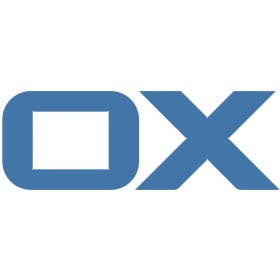Open-Xchange (OX App Suite) — Modular Email and Collaboration Platform
General Information
Open-Xchange (OX App Suite) is a modular platform that combines email, calendars, contacts, and productivity apps under one roof. It’s widely used by service providers and enterprises that want to deliver a Gmail- or Outlook-style experience without handing everything over to Google or Microsoft.
Unlike smaller mail stacks, OX App Suite is designed from the ground up as a multi-tenant service. That’s why it often shows up in ISP and hosting environments, but it also runs well on enterprise servers when the goal is to keep data and compliance in local hands.
How It Works
At the core sits a mail backend that handles IMAP, POP3, and SMTP, often paired with Postfix and Dovecot. On top of that comes the OX web interface, which brings together mail, calendars, address books, tasks, and document editing. Mobile sync works through ActiveSync, CalDAV, and CardDAV.
The suite is modular: admins can deploy just mail and contacts, or add OX Documents, Drive, and chat modules. User authentication integrates with LDAP, AD, or external identity providers. Security features like TLS, SPF/DKIM/DMARC, and role-based permissions are standard.
Functions
| Feature | In practice |
| Platforms | Linux servers; browser clients; ActiveSync, CalDAV, CardDAV for devices |
| Webmail | Modern UI with conversation view, filters, signatures |
| Collaboration | Shared calendars, contacts, tasks; optional chat and video |
| Documents | OX Documents for collaborative editing (Word/Excel/PowerPoint formats) |
| File storage | OX Drive module for personal and shared files |
| Security | TLS, 2FA, SPF/DKIM/DMARC, AV/spam filters |
| Admin console | Central web console for domains, users, quotas, branding |
| Multi-tenant | ISP-friendly; host many domains with policies and logos |
| Integration | LDAP/AD, external storage backends, third-party SaaS tie-ins |
| License | Open source core; commercial editions with vendor support |
Installation Guide
1. Prepare a Linux host (Debian, Ubuntu, or RHEL-based).
2. Add Open-Xchange repositories and install core packages.
3. Configure mail transport (Postfix/Dovecot) and connect to OX.
4. Set up the database (MySQL/MariaDB) for groupware data.
5. Enable HTTPS via Let’s Encrypt or custom certs.
6. Configure identity backend (LDAP/AD or local).
7. Deploy optional modules: OX Drive, OX Documents, chat.
8. Test webmail, calendar sync, and ActiveSync with clients.
Large deployments usually sit behind load balancers and use clustered databases to handle growth.
Everyday Use
– ISPs and hosters run OX App Suite to sell branded mail and collaboration packages to customers.
– Enterprises deploy it on-prem to replace Microsoft Exchange with a browser-based alternative.
– Public sector uses it to keep email and files inside national infrastructure while giving staff modern collaboration tools.
– Schools and universities run it for students who expect Google-style services, but without external data exposure.
Day to day, users send mail, edit documents in the browser, and share files. Admins mostly handle account provisioning, quotas, and spam tuning.
Limitations
– Installation and tuning are heavier than single-server tools like Modoboa or hMailServer.
– OX Documents is powerful but can feel slower compared to Microsoft Office or Google Docs.
– Requires more hardware planning: multi-tenant setups need clustered databases and caching layers.
– The open-source core is free, but many features require commercial licensing.
Comparison
| Tool | Platforms | Strengths | Best Fit |
| OX App Suite | Linux + browsers | Full collaboration stack, ISP-ready multi-tenant | Hosters, large enterprises |
| Zimbra OSE | Multi-platform | Mature open source groupware | Schools, SMBs, mixed deployments |
| Grommunio | Linux | Exchange-like with chat/video included | Enterprises seeking MS alternative |
| Microsoft 365 | SaaS/Windows | Deep Office integration, Teams, OneDrive | Corporates tied to MS ecosystem |
| Google Workspace | SaaS | Seamless collaboration at scale | SaaS-first companies |
Notes from the Field
Admins who’ve deployed OX App Suite say the platform scales well but expect to spend time on planning — especially databases and load balancing. ISPs appreciate its multi-tenant design: branding and per-domain policies are straightforward. A common tip is to start with core mail and calendars, then layer in OX Documents and Drive once the basics are stable. For users the UI feels modern, which helps with adoption, but document editing performance depends heavily on server resources.

